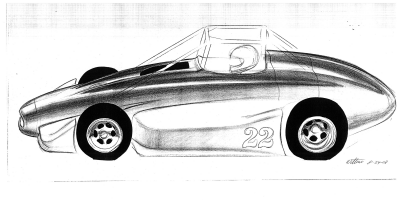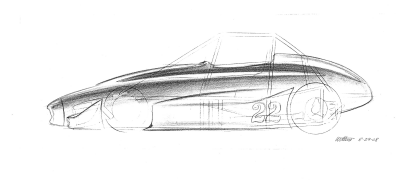The Way It Is/ Looking ahead to USAC's 2010 Gold Crown series
by Gordon Kirby Former Lola and Reynard designer Bruce Ashmore has been cogitating at length about the 2011 IndyCar rules and working hard to make sure his new Ashmore USAC Gold Crown car will be a roaring success when it debuts
Former Lola and Reynard designer Bruce Ashmore has been cogitating at length about the 2011 IndyCar rules and working hard to make sure his new Ashmore USAC Gold Crown car will be a roaring success when it debuts
in 2010. Ashmore has lived in Indianapolis for fifteen years and in recent years he's produced a design study for Champ Car's Panoz spec car and evolved his own theories of what the Indy car of the future should be. And after calling for drastic cuts in downforce in Indy car racing, Ashmore has changed his mind about what the aerodynamic package should be for the IRL's 2011 IndyCar.
He's also been increasingly involved in the design and development of USAC's new 2010 Gold Crown car. The new Gold Crown cars will be built by three chassis manufacturers--Riley Technologies, Devin Race Cars and a new company Ashmore is putting together. An attempt was made by USAC two years ago to introduce a new Silver Crown car, but the concept stumbled and will be re-introduced in 2010 as the Gold Crown car. USAC's new boss Kevin Miller is the key man in making a revitalized USAC and its new Gold Crown series successful.
"You had a CART-IRL type of situation because the guys who had the old cars started their own series they called the Big Car series so Kevin had to park the new car and bring back the old car," Ashmore explained. "The Big Car series ran for a couple of years and was starting to gain some momentum, but it was very confusing because you had new Silver Crown cars and old Silver Crown cars. So Kevin said if he was going to fix USAC the first thing he had to do was to fix the confusion and put them back together.
"The new generation car needed some work. It needed a new body, a new look and it needed an organization to run the series. A lot of work had already gone into that and everybody agreed the right thing to do was to park the new car for now and put the Silver Crown series back together. Everyone loves Silver Crown and it is here to stay. The next step and everyone agreed was that the logical choice was to call the new car the Gold Crown car."

© AshmoreDesign.com
"This is about forming a ladder system from quarter-midgets through midgets to Silver Crown, Gold Crown and then into Indy Lights and IndyCar," Ashmore commented. "So there would be two ladder systems leading to IndyCar, one from traditional American ovals and one from road courses."
Ashmore originally designed his car for Chris Paulsen at C&R Racing, but he's bought the design rights and is currently setting up a new company to build Ashmore Gold Crown cars.
"This has been a lot of fun so far and it's great to be able to help develop a series in the form that I truly believe in," he remarked. "I am actually putting my money where my mouth is with regards to a lower downforce or no downforce formula and helping USAC in developing the series that I believe in.
"This will be an 800 hp car traveling at under 200 mph on the 1.5-mile tracks and will have a great new look with very little downforce. The new Gold Crown series will be what Bobby Rahal, Mario Andretti and I have been talking about. It will become a great transition series from the traditional American offset, front-engined open-wheel cars into the square, or symmetrical layout car like an IndyCar.
"So the Gold Crown drivers will be able to move into Indy Lights to learn how ground effects work and deal with pitch sensitivity, and then move up into the big cars where you have power and downforce. Gold Crown will be the destination series of USAC but it can lead on and up into IndyCar racing if the competitor desires or makes the cut.
"The Gold Crown series also has the same wheel and tire sizes as an IndyCar so companies wishing to develop a product for IndyCar in the future could develop a tire for the Gold Crown series first which puts them in the same pitlane as IndyCar."
And after being a big proponent of cutting downforce in Indy car racing, Ashmore has changed his mind.
"I've been thinking about all of this a lot lately and reading all the various opinions," Ashmore commented, "and I've come to the conclusion that perhaps IndyCar should stick to their current direction and leave the downforce as it is. This is their identity and I am proud of them to want to stay with what they believe in."
Ashmore has become a believer in Al Unser Jr's ideas, expressed in this space at the end of July.

© AshmoreDesign.com
"I like Al Jr's approach," Ashmore said. "I've been a great fan of his over the years. It's good to have him back in racing and have him on the team that develops the new Indy car. His ideas will help improve the racing and driver experience."
Despite his change in thinking about the quantity of downforce an Indy car should generate, Ashmore is convinced that many of his ideas from the past few years can still be effectively applied to the 2011 IndyCar formula.
"I see a car where the car in front disturbs the car in back as little as possible with great attention paid to capturing all the vortices off all the surfaces, or producing less vortices in the first place," Ashmore explained. "Now I'm back to what I was saying a few years ago when I was working with the Champ Car committee, but leaving the downforce where it is.
"I wish the IndyCar guys all the best with what they are doing and I can now see that it should stay as it is because we will then have a complete set racing series which will all have their strengths on different tracks and will also look different when racing on the same tracks. When IndyCar gets back to the status level it deserves then tracks will be designed for them. This nearly happened before and was certainly talked about in the '90s. These tracks might be wide, flat ovals and because of their downforce level, today's Indy cars would look great on those tracks.
"Then for the tracks with banking the IRL can carry on controlling the rules closely so they will retain the great side-by-side racing which a lot of the fans enjoy, but with less crashes if they have a front wing that acts as a bit of a nerf bar and bodywork protecting the rear tire. So IndyCar will be different to USAC and NASCAR."
One thing Ashmore remains an ardent supporter of IndyCar adopting is his idea of widening the bodywork between the wheels to equal the outer edge of the tires. This concept was explained in detail in this space on June 23rd of this year. Ashmore is convinced his concept would seriously reduce the possibility of cars flying into the air when they collide.
"I would like to seem them make a change to their cars to improve the racing," Ashmore said. "That is the area I am most passionate about, which is to bring the side pods out to the outside edge of the tires and therefore protect the leading edge, or spinning treaded surface of the rear tire, to stop the interlocking wheel-type accidents."
Ashmore also hopes the new 2010 Gold Crown will work so well that the IRL may learn some useful lessons about reducing downforce.
"We're going to try this approach in the Gold Crown series and IndyCar can look at what USAC is doing and if they like what they see they could try our approach to downforce on some of their tracks in the future. Maybe some tracks they would have a super high-downforce kit and some tracks you would have a super low-downforce kit."
Ashmore also believes the IRL should adopt some form of kenetic energy recovery systems (KERS), but not until somewhere around 2013.
"If they manage to have three or four engine manufacturers duking it out, then I'm a big supporter of looking at KERS systems and regenerative braking and alternative fuels," Ashmore said. "You don't have to do all of them, but regenerative braking and KERS are great things to develop. They're very expensive but racing is a great medium to develop these things and as that happens they will come down in price as everyone figures out how to make it work. I think spec car racing is here to stay so you've got to have something that people can develop in racing.
"I would say they would probably be better off doing it in 2013. It would be a lot of work to do for 2011. Ideally, you would continue to work with your engine manufacturers who are coming in 2011 to agree on the best way of introducing KERS a couple of years later. The biggest danger is trying to do too much at once and I think a new engine is enough for everyone to cope with in the first step. But I think the top levels of racing should be involved in developing more efficient road cars."
So that's the latest in veteran race car designer Bruce Ashmore's evolving ideas about the Indy car of the future. Meanwhile, I wish Ashmore and USAC the best of luck with the 2010 Gold Crown series. If it's as successful as Ashmore believes, it will be a healthy and welcome boost for American open-wheel racing.
Auto Racing ~ Gordon Kirby
Copyright 2008 ~ All Rights Reserved
Copyright 2008 ~ All Rights Reserved
Top of Page